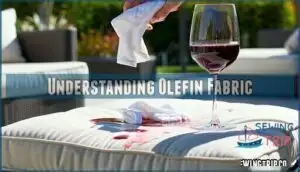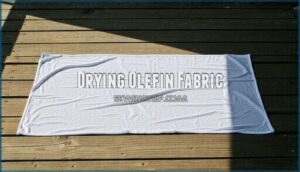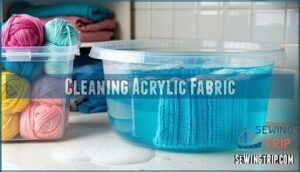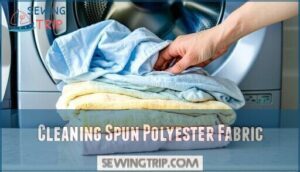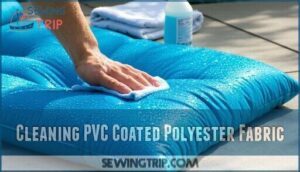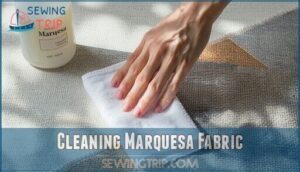This site is supported by our readers. We may earn a commission, at no cost to you, if you purchase through links.
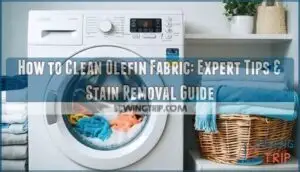
This synthetic material resists stains naturally, so spills usually wipe away with a damp cloth. For deeper cleaning, toss it in the washing machine on a gentle cycle with cool water.
You can machine wash olefin without worrying about shrinkage or fading, unlike many natural fabrics. Skip the hot water and high heat when drying to keep the fibers happy.
The best part? Olefin dries quickly, so you won’t be waiting around all day. Most everyday messes surrender without a fight, though tougher stains might need special attention. Olefin is a material that is easy to clean and maintain, making it a great choice for those who want a low-maintenance fabric.
Table Of Contents
- Key Takeaways
- How to Clean Olefin Fabric
- Understanding Olefin Fabric
- Cleaning Tips for Olefin Fabric
- Repairing and Caring for Olefin Fabric
- Cleaning Acrylic Fabric
- Cleaning Spun Polyester Fabric
- Cleaning PVC Coated Polyester Fabric
- Cleaning Marquesa Fabric
- General Care Tips for Outdoor Fabrics
- Tips for Removing Stains From Olefin Fabric
- Frequently Asked Questions (FAQs)
- Conclusion
Key Takeaways
- You’ll clean olefin fabric easily with cool water and mild detergent since it naturally resists stains and moisture.
- Don’t use hot water or high heat when drying because olefin’s synthetic fibers can melt and get permanently damaged.
- You can machine wash olefin on gentle cycles, but air drying works best to prevent heat damage and maintain the fabric’s durability.
- You’ll handle most stains by blotting immediately and using specific treatments like dish soap for oil or rubbing alcohol for ink.
How to Clean Olefin Fabric
You’ll find cleaning olefin fabric straightforward since it’s designed to resist stains and moisture.
The synthetic material responds well to mild detergents and lukewarm water, making routine maintenance simple for most household items, as it is designed to be easy to clean.
General Cleaning Instructions
Regarding olefin fabric cleaning, you’ll want to start with the basics. Mix mild detergent with lukewarm water, then use a soft brush scrub technique to gently work the solution into the fabric.
After a thorough lukewarm water rinse, employ proper air dry methods by avoiding heat sources.
For storage best practices, keep your clean olefin in cool, dry spaces.
Treating Stains on Olefin Fabric
When dealing with stains on your olefin fabric, quick action makes all the difference between success and frustration.
Quick action beats hesitation every time when stains strike your olefin fabric.
Immediate blotting removes up to 85% of water-based stains, while oil-based spills need specialized treatment.
Here’s your stain-fighting game plan:
- Oil stain removal: Apply dish soap directly, let sit briefly, then rinse thoroughly with lukewarm water
- Ink stain removal: Dab with rubbing alcohol using a clean cloth, avoiding spreading the mark
- Food stain removal: Blot excess, scrub gently with mild detergent solution, rinse completely
- Blood stain removal: Use cold water immediately, followed by mild soap if needed
- Mildew stain removal: Mix equal parts white vinegar and water, scrub lightly, air dry
Remember, olefin fabric stain removal works best when you work from the stain’s edge toward the center, preventing rings.
For regular upkeep, consider consistent fabric maintenance to extend its life.
Ironing Olefin Fabric
Why risk melting your olefin fabric with traditional ironing methods? Heat damage poses the biggest threat to these synthetic fibers.
Olefin’s resistance to damage makes it ideal for heavy use upholstery.
| Method | Safety Level |
|---|---|
| High heat iron | Dangerous – causes melting |
| Low heat + pressing cloth | Risky but possible |
| Steam usage | Safe alternative |
| Air drying flat | Best prevention |
Skip conventional ironing methods entirely. Olefin fabric’s low melting point makes ironing temperature control critical for preventing damage and maintaining fabric protection through safer wrinkling alternatives.
Storing Olefin Fabric
Your olefin fabric deserves proper storage to maintain its durability and appearance.
When storing fabric care items, humidity control prevents mold while folding techniques minimize creasing.
Here’s your fabric storage checklist:
- Clean thoroughly – Remove all dirt and stains before storage
- Fold loosely – Use acid-free tissue paper between layers
- Choose breathable containers – Fabric bags beat plastic for fabric maintenance
- Control environment – Cool, dry spaces with pest prevention measures
Space optimization matters, but avoid cramming.
Cover options like cotton sheets protect against dust while allowing airflow.
Your storage tips investment pays off when you retrieve fresh, ready-to-use olefin fabric.
How Often to Wash Olefin Fabric
After ensuring proper storage, understanding washing frequency becomes key to maintaining your olefin fabric’s performance.
Regular cleaning schedules depend on your activity levels and environmental factors.
You’ll want to wash activewear after each sweaty workout to prevent odor buildup.
For routine cleaning of less-used items, monthly washing works well for preventative care.
| Usage Frequency | Recommended Washing |
|---|---|
| Daily active use | After each wear |
| Weekly outdoor use | Every 2-3 uses |
| Monthly casual use | Once per month |
| Seasonal storage items | Before/after storage |
This olefin cleaning guide helps prevent over-washing while maintaining freshness.
Your olefin maintenance tips should focus on actual soil rather than arbitrary schedules.
Smart olefin fabric care extends longevity substantially.
Understanding Olefin Fabric
Most people don’t realize olefin fabric packs serious performance into an affordable package. This synthetic powerhouse, also known as polypropylene, comes from propylene polymers that create a versatile textile with impressive capabilities.
Most people overlook olefin’s unbeatable combination of performance and value in synthetic textiles.
Olefin fabric offers several key advantages:
- Superior UV Resistance – Maintains color vibrancy even with constant sun exposure
- Exceptional Water Resistance – Naturally hydrophobic fibers repel moisture effectively
- Outstanding Stain Resistance – Synthetic composition prevents liquid absorption
- Remarkable Olefin Durability – Withstands heavy use without breaking down
The fiber composition makes olefin naturally resistant to mildew and mold growth, perfect for humid environments. Its lightweight nature doesn’t sacrifice strength, making it ideal for outdoor furniture cushions and carpeting.
This 100% recyclable material provides excellent value while maintaining performance standards. Understanding these characteristics helps you appreciate why proper olefin fabric care matters for long-term satisfaction.
Cleaning Tips for Olefin Fabric
Cleaning olefin fabric properly requires the right approach to maintain its durability and stain resistance.
You’ll need to choose appropriate detergents, water temperatures, and drying methods to keep your olefin items looking their best without damaging the synthetic fibers.
Selecting The Right Detergent
Choosing the right cleaning products makes all the difference when maintaining olefin fabric. You’ll want mild detergent or pH neutral detergent for regular cleaning, as these cleaning solutions won’t damage the synthetic fibers.
Enzyme detergents work exceptionally well for organic stains, breaking down proteins and oils effectively. Consider using a specialized olefin detergent for best results.
Whether you prefer scented vs. unscented options is personal preference, but avoid harsh chemicals that leave residue concerns.
Choosing The Water Temperature
Water temperature plays a critical role in maintaining your olefin fabric’s integrity. Cool to warm water prevents heat damage while ensuring effective detergent activation for thorough cleaning.
Hot water can cause fiber melting, permanent wrinkles, and color loss that can’t be reversed.
- Use cool or lukewarm water (below 86°F) to prevent fiber melting and maintain fabric structure
- Avoid hot water completely – it causes irreversible heat damage and compromises stain removal effectiveness
- Cold water rinses help preserve colorfastness and support energy-efficient cleaning practices
- Warm water activates mild dish soap better than cold while staying safe for synthetic fibers
- Proper water temperature maintains olefin’s moisture-wicking properties and extends fabric lifespan
Selecting The Proper Cycle Setting
Select gentle cycles for delicate olefin items to prevent fiber damage.
Heavy duty settings work well for bulky outdoor cushions that need thorough olefin cleaning solutions.
Most olefin fabrics benefit from permanent press cycles, which balance cleaning power with fabric protection.
When using mild dish soap and lukewarm water, the gentle agitation helps with olefin stain removal without compromising the synthetic fibers’ integrity, using a gentle approach to preserve the material.
Drying Olefin Fabric
Air drying prevents heat damage that can melt or weaken olefin fibers.
Skip tumble drying entirely—it’s your fabric’s worst enemy. Instead, lay items flat on a clean towel or hang them in shade.
Proper air drying methods reduce drying time while ensuring wrinkle prevention. Olefin, like polyester, can suffer from excessive heat damage if not dried correctly.
Use lukewarm water for final rinses, then gently blot with a soft cloth before drying to prevent excessive heat damage.
Repairing and Caring for Olefin Fabric
Two proven methods tackle olefin fabric maintenance effectively. Seam Repair becomes simple with hand-sewing small tears or fabric glue for larger holes.
Pilling Removal requires gentle tools—use a fabric shaver or lint roller to restore smoothness without damaging fibers. Fade Prevention means avoiding direct heat during cleaning and storage.
Mildew Control means confirming complete air-drying after washing. Restoring Shape happens naturally when you store items properly folded.
Your olefin fabric maintenance routine should include reapplying waterproofing spray every six months. This olefin care guide prevents common issues like pilling while extending fabric life substantially.
Cleaning Acrylic Fabric
Acrylic fabric cleaning requires careful attention to temperature control and gentle handling techniques. Unlike olefin, acrylic fibers can’t withstand high heat, so you’ll need to adjust your approach accordingly.
Mix mild detergents with warm water around 100 degrees Fahrenheit for your cleaning solution. This temperature range protects the synthetic fibers while effectively lifting dirt and stains.
For stain treatment, let stubborn spots soak in your cleaning solution for 10-20 minutes before washing. Coffee, wine, and oil stains respond well to this method. Acrylic fabric offers excellent stain resistance when properly maintained.
Hand washing or using delicate machine cycles works best for fabric cleaning. Proper drying methods are essential – lay flat or hang to air dry completely.
Avoid heat-based drying which can damage fibers. For mildew removal, use a vinegar solution if needed. When repairing damage, consider professional help for tears.
These cleaning tips help maintain acrylic’s durability and appearance.
Cleaning Spun Polyester Fabric
While acrylic fabric requires gentle handling, spun polyester offers more durability for outdoor applications. You’ll find spun polyester easier to maintain than other synthetic fabrics, though proper cleaning techniques remain important.
When dealing with Polyester Stain Removal and Washing Spun Polyester, follow these steps:
- Pre-treat stains immediately with a mild cleaning solution or diluted dish soap before they set
- Wash in cool water using gentle detergent to preserve fiber integrity and prevent shrinkage
- Skip bleach and fabric softener as these chemicals can weaken polyester fibers over time
- Air dry or use low heat to maintain fabric shape and prevent melting
Drying Techniques for spun polyester focus on gentle heat. Turn garments inside-out before washing to reduce pilling. Don’t overload your machine – polyester needs room to move freely. These cleaning tips help maintain the fabric’s natural wrinkle-resistance.
Storing Polyester properly means keeping it in cool, dry spaces away from direct sunlight. With consistent outdoor fabric care, your spun polyester will resist fading and maintain its soft texture for years.
Cleaning PVC Coated Polyester Fabric
PVC coated polyester fabrics often require specialized PVC cleaning solutions to maintain their protective coating integrity. The vinyl-like surface makes stain resistance a standout feature, but proper cleaning techniques prevent coating damage.
Start by testing any cleaning solution on a hidden area to preserve polyester coating integrity. Mix warm water with a small amount of mild detergent and oxygen bleach for your cleaning guide approach.
This combination tackles stains while supporting mildew prevention. Dab the stain gently with a clean cloth—scrubbing can compromise the coating. For stubborn marks, let the solution sit briefly before rinsing thoroughly.
For delicate items, consider natural cleaning agents to avoid damage. These fabric cleaning methods work best when you act quickly on spills. The PVC coating repels most liquids, giving you time to clean effectively.
Always air dry to avoid heat damage. If you notice small tears, address repairing tears immediately to prevent moisture from penetrating the polyester base. Regular maintenance using these fabric cleaning techniques keeps your outdoor cushions and awnings looking fresh for years.
Cleaning Marquesa Fabric
Keeping Marquesa fabric pristine requires understanding its unique recycled composition and proper care techniques. Made from 100% recycled plastic bottles, this eco-friendly upholstery material combines sustainability with exceptional durability.
Here’s how to maintain your Marquesa fabric investment:
- Use mild soap solutions: Mix gentle detergent with lukewarm water for effective Marquesa stain removal without damaging fibers
- Spot clean immediately: Address spills quickly to prevent permanent staining on the open mesh construction
- Air dry completely: The fabric’s quick-drying properties work best when you avoid machine drying or heat sources
- Apply fabric protectant: Reapply UV-resistant spray every six months for outdoor Marquesa fabric maintenance
- Hand wash only: Never machine wash or soak this delicate recycled material
Specific detergents should be pH-neutral to preserve the fabric’s integrity. The open weave construction naturally resists odors and moisture retention, making drying techniques straightforward.
While repair options are limited due to the specialized mesh structure, proper maintenance tips guarantee longevity. This approach to cleaning olefin upholstery alternatives keeps your sustainable fabric looking fresh for years.
General Care Tips for Outdoor Fabrics
Taking care of outdoor fabrics goes beyond just cleaning them when they get dirty.
You’ll want to focus on prevention and protection to keep your olefin and other outdoor materials looking fresh for years to come.
Choosing Quality Fabrics
Looking to invest in quality outdoor fabrics? You’ll want to examine fiber density, weave tightness, and UV resistance ratings before making your choice.
Synthetic fabric options like olefin fabric offer excellent durability when they meet high abrasion rating standards. Check for colorfast testing results to confirm your fabric won’t fade after a season of sun exposure.
Quality fabric durability comes from tight construction and proper treatment, so don’t skimp on these specifications. Consider fabric weights and deniers for enhanced durability.
Using Fabric Protectants
Quality fabrics deserve quality protection. Apply olefin fabric protector every six to twelve months for maximum stain resistance and UV protection.
Waterproofing sprays create an invisible barrier that repels spills and prevents fading. Consider using a dedicated fabric solution for best results.
Test fabric care products on hidden areas first, then spray evenly following manufacturer instructions. Proper protectant application extends your outdoor fabric care routine substantially, ensuring maximum stain resistance and UV protection.
Protecting Against Spills, Stains, and Fading
Beyond fabric protectants, proactive spill prevention keeps your olefin looking fresh and vibrant for years to come.
- Blot spills immediately – don’t let liquids penetrate fibers
- Apply olefin fabric protector every 6-12 months for enhanced stain defense
- Position furniture away from direct sunlight to maintain colorfastness tips
- Use coasters and placemats during outdoor dining to prevent accidents
- Follow proper stain removal techniques when accidents happen
Quick action makes all the difference in removing stains olefin fabrics might absorb.
Proper Rinsing and Drying Techniques
After protecting your fabrics from spills and stains, proper rinsing and air drying become your next priorities.
Rinse repeatedly with cool water until you’ve eliminated all detergent residue—leftover soap attracts dirt like a magnet.
Air dry completely before storing to prevent mildew and maintain fabric integrity.
Skip the tumble dryer since heat damages olefin fibers and causes shrinkage.
UV Protection and Waterproofing Options
UV coatings and waterproofing sprays create an extra shield against sun damage and moisture.
Apply these fabric stabilizers every 3-6 months to boost outdoor durability. Solution dyeing in olefin provides built-in protection, but added treatments help maintain peak performance.
Consider using a specialized protection product for enhanced defense.
For cleaning outdoor olefin and outdoor upholstery, these protective layers make maintenance easier while extending fabric life substantially, providing an extra layer of sun damage protection and moisture resistance.
Tips for Removing Stains From Olefin Fabric
Five essential stain removal strategies can transform your olefin fabric from disaster to pristine condition. While olefin fabric resists most stains naturally, certain culprits like oil and ink require targeted approaches for effective removal.
- Oil Stain Removal: Blot immediately, then apply dish soap directly to the stain. Let it penetrate for 10 minutes before rinsing with lukewarm water.
- Food Stain Removal: Create a solution of mild detergent and water, gently scrub with a soft brush, then rinse thoroughly to prevent residue buildup.
- Ink Stain Removal: Dab rubbing alcohol on the stain using a cotton ball, working from outside edges inward to prevent spreading.
- Blood Stain Removal: Use cold water only—hot water sets protein stains. Apply enzyme-based cleaner if the stain persists after initial treatment.
- Mildew Stain Removal: Mix equal parts white vinegar and water, scrub gently, then air dry completely to prevent future growth. For delicate items, consider gentle cleaning solutions to avoid damage.
Frequently Asked Questions (FAQs)
Can You Dry Clean olefin fabric?
Like traversing a minefield, dry cleaning olefin requires caution.
You can dry clean it, but heat sensitivity makes it risky.
The high temperatures might melt the synthetic fibers, so choose low-heat methods or skip dry cleaning entirely.
Are olefin fabrics the same as regular fabrics?
No, olefin fabrics aren’t like regular fabrics.
You’re dealing with synthetic fibers made from polypropylene, not natural materials like cotton or wool.
They’re more stain-resistant, water-repellent, and durable than traditional fabrics.
Does olefin fabric wrinkle?
Wrinkles won’t be your biggest concern with olefin fabric. This synthetic material resists wrinkling naturally, though lower-quality versions might show some creases over time depending on manufacturing quality.
Do olefin fabrics pill?
Yes, olefin fabrics can pill, but they’re naturally more resistant to pilling than many other materials.
You’ll notice pilling mainly occurs from friction and wear over time.
Use a fabric shaver or lint roller to remove pills gently.
Can you put olefin in the dryer?
Don’t put all your eggs in one basket with heat and olefin fabric.
You shouldn’t use the dryer since high temperatures can melt synthetic fibers.
Instead, air dry your olefin items to maintain their durability and prevent damage.
Can olefin be dyed?
Unfortunately, you can’t dye olefin fabric because it’s basically plastic that resists absorbing liquids. The synthetic fibers won’t accept traditional fabric dyes, making color changes impossible through standard dyeing methods.
Can you wash 100% olefin fabric?
You can wash 100% olefin fabric using mild detergent and lukewarm water.
However, avoid hot water and high heat when drying since olefin can melt at high temperatures, potentially damaging your fabric permanently.
Can olefin get wet?
In regard to water, olefin fabric is like a duck’s back—naturally water-resistant! You can get it wet without worry since it’s hydrophobic and repels moisture, drying quickly.
Can you steam clean olefin fabric?
Yes, you can steam clean olefin fabric safely. The hot water extraction method effectively removes stubborn grime and allergens from olefin carpets and upholstery while maintaining fabric integrity.
Can olefin fabric be machine washed safely?
Machine washing olefin fabric isn’t universally safe—it depends on construction and manufacturer guidelines.
While some olefin items handle gentle cycles with cold water, others risk melting or damage from agitation and heat, making hand washing the safer bet.
Conclusion
Caring for olefin fabric is like having a low-maintenance friend who never asks for much.
Now that you’ve mastered how to clean olefin fabric, you can enjoy its durability and stain resistance with confidence.
Remember to stick with cool water, gentle cycles, and mild detergents for best results.
Your olefin items will reward your simple care routine with years of reliable performance and easy cleanup, thanks to their stain resistance.

